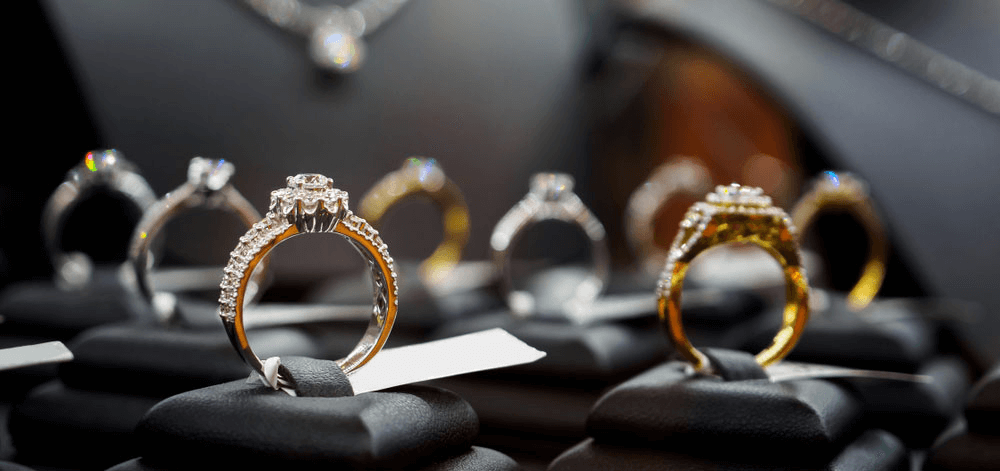How Much Do Pawn Shops Pay for Diamond Rings?

For many people, a diamond ring is one of their most valuable possessions. So, when they're in need of some quick cash, it may make sense to pawn the ring. Its high value makes it strong collateral for a no-credit-check loan.
But how much can you actually get for a diamond ring? Is it worth the hassle? Read on to learn how diamond rings are valued, what determines their retail and resale values, and how much pawnbrokers can typically offer you for your diamond ring.
What percentage do pawn shops pay for jewelry?
First, it's important to understand how pawnbrokers assess jewelry as the collateral for their loans. It all comes down to how much they envision earning if they needed to sell the item. Remember, pawnshops want you to reclaim your item, as it costs them money to store it. They make money from the items that are sold to them. However, they need to be able to recoup their losses if you don't repay the loan.
While jewelry may be very expensive to purchase, it's not always easy to sell. Some pieces may not appeal to a wide market, and others simply don't hold value compared to their brand-new counterparts. Often, pawnbrokers rely on the current market value of the actual precious metals and gemstones in the piece — not how they're designed or assembled. In rare cases, if the jewelry was created by an esteemed designer, the piece may bring more. Usually, though, your item's resale value will reflect the current diamond market price.
As diamonds don't hold their value very well due to the extremely high retail markup in new jewelry stores, you can expect to get about 30-60% of its current market value — which may be significantly less than you paid. If your piece is exceptionally well crafted, in excellent shape, and of high-karat quality, you may realize up to 75% of its market value. Again, though, this is usually much less than the retail price.
How do I find out what my diamond ring is worth?
Before pawning your diamond ring, take note of its characteristics. Exceptional cut, clear color, clarity, and carat (i.e. the gem's size) all influence its market value. Keep in mind that not all pawnbrokers may be skilled jewelry appraisers. If you're not sure of your diamond's metrics, consider having a qualified jeweler or gemologist assess it. Some pawn stores, like Pawn America in Minnesota and Wisconsin, have in-house GIA Graduate Gemologists (a certification that’s not easy to earn) and offer professional appraisals.
In general, a well-cut, colorless, and flawless diamond is considered more valuable. You'll also get more money per carat (or partial carat). Sincemost rings don't exceed 0.5 to 1 karats, though, your best bet is to assess the diamond's color and quality. For example, using GIA’s D to Z color grading scale, a D-level color diamond grade with very slight inclusions will be ‘colorless’ and appear flawless to the naked eye.. These diamonds are worth $6,250 on the open market at retail, even if you paid $10,000 for the ring. A pawnbroker will usually offer $3,100 to $4,350 for that diamond.
How can I get the most money for my diamond ring?
Do your homework before taking your ring to a pawnshop. Some shops may not have staff who can accurately appraise your ring so ask if they have pawn brokers who have been trained by GIA or trained by a GIA Graduate Gemologist they have in their organization. Bring all documentation of its age, karat level, and origins, and consider getting an expert appraisal if you're not certain. Remember, pawnbrokers are basing their offers on the current market value of the precious metals and gemstones. Get an accurate picture of your jewelry's quality before approaching a pawnshop.
If the diamond ring has a gold band, you can also incorporate the value of the gold. Keep in mind that diamonds are heavy, so to support their weight, gold rings may need a sturdier (i.e. lower karat) alloy to hold them. This means that gold rings with diamonds are often lower-karat than plain gold bands. However, gold holds its value very well, which can drive up the overall market value of your ring.
Where can I sell my diamond ring for the most money?
If you'd rather sell your diamond ring than pawn it, you'll probably receive more cash. Pawnbrokers are usually willing to offer more for items they know they'll be able to sell.
Depending on supply and demand, they can may be able to charge a higher price, therefore, they may be able to offer you more if you're willing to relinquish the ring. Expect to realize up to 75% of a diamond ring's market value. While this may be less than what you paid for the ring, it can still be a significant amount of cash.
Do diamond rings hold their value?
While gold rings (and all gold jewelry) tend to retain their value, diamond rings do not, however it is due to the fact that new jewelry stores have extremely high profit mark up, higher than most any product sold. This isn't to say they don't have a high resale value. Diamonds are still precious gemstones with a high level of rarity, which drives up their price. However, when you buy a diamond ring, you're not only paying for the stone but also for the assembly, design, sales, marketing and profit margin for the new jewelry store. That's why most diamond rings drop in value by 50% as soon as you walk out of the store after buying them.
Pawnbrokers will typically offer no more than 75% of a diamond ring's resale value, which may be as low as 30% of the original retail piece. So, for example, a $10,000 retail price diamond ring sold in a new jewelry store has about a $3,000 resale price, and if you pawn it, you'll likely only get $2,250 at most. This extremely high new jewelry store profit margin is what upsets customers when they want to sell their jewelry item.
How much can you get from pawning a ring?
With that in mind, remember that jewelers get wholesale prices for diamond rings. This means they can stock their shop for less money, then add a profit markup. By contrast, pawnbrokers don't have that option as their wares are sourced from customers. So, if you're hoping to get more for your ring, don't take it to your jeweler to sell. Get it appraised, then approach your pawnshop with the diamond's credentials.
Pawnbrokers are eager to sell to people who can't afford typical retail jewelry mark up prices. This means they're willing to buy your ring for more, as compared to a jeweler who can always buy diamonds wholesale! Whether you're selling a ring outright or pawning it, a pawnbroker will see this as a good business opportunity. Expect to get 20%-50% of a diamond ring's original cost, while jewelers may pay you less than 10% — if at all.
Wrapping Up
Pawning or selling a diamond ring can be a difficult process. Sadly, you'll never get the same amount of money that you paid. However, pawnshops are often the best route for turning your diamond ring into cash. While jewelers are notorious for buying diamonds for next to nothing and marking up the price, pawnbrokers need to serve a market of customers seeking secondhand rings. Plus, they base their offers on current market values rather than wholesale prices.
To successfully sell your diamond ring, do your research. Know your diamond's characteristics, including cut, clarity, color, size, age, shape, quality, and overall condition. Diamonds set in gold bands or accompanied by other precious gemstones will fetch more. Remember, knowledge is power when it comes to pawning or selling your diamond ring!

